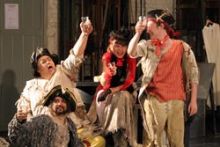In conjunction with The Days of German Culture in Ukraine, the Lesia Ukrainka National Russian Drama Theater, in collaboration with its German colleagues, staged the play The Persecution and Assassination of Jean-Paul Marat as Performed by the Inmates of the Asylum of Charenton Under the Direction of the Marquis de Sade.
The premiere was held on Sept. 18, ahead of the Kyiv company’s season opening scheduled for Oct. 4 (the play will also be staged in Munich on Nov. 4).
Alla Rybikova, the project coordinator, author of the stage version, and translator of individual scenes that were left out of Lev Ginsburg’s published translation, told The Day about the play. Rybikova has been closely associated with the Lesia Ukrainka company’s creative contacts with Germany, and a number joint creative projects have come to fruition thanks to her:
“The Embassy of the Federal Republic of Germany in Ukraine proposed to continue cooperation in staging bilingual plays. The first joint project of the Lesia Ukrainka National Russian Drama Theater and the Institute of Drama Studies at Ludwig Maximilians University (LMU) in Munich was Shakespeare’s Romeo and Juliet, where all the Montagues spoke German and the Capulets — Russian. The play was a success in Ukraine, Germany, Switzerland, and other countries.
“Then our German colleagues invited us to work on The Persecution and Assassination of Jean-Paul Marat as Performed by the Inmates of the Asylum of Charenton Under the Direction of the Marquis de Sade, a razor-sharp political play by the German antifascist Peter Weiss. The play was written in 1964 and successfully staged throughout Europe in the 1960s, although it was banned in the former USSR because it evoked ‘unnecessary’ associations with the Soviet totalitarian regime. The author was also fascinated by Trotskyism, and this was not encouraged either.“
In the early 1990s there were several attempts to stage Marat/Sade in Moscow (Taganka Theater) and Kyiv (Molodizhnyi Theater), but they did not spark any sensations. The totalitarian regime had just collapsed and many people had high hopes for the future. This play is especially acute today, after the Orange Revolution. The French Revolution, which serves as the setting for the Weiss play, helps us understand how a revolution materializes, who is on the barricades, and who benefits from this revolution later.
Weiss’s play follows the aesthetic lines of Bertold Brecht’s theater. The plot is based on a historical fact. As an inmate of the Charenton Asylum, the Marquis de Sade and other patients staged plays for the general public (some of the patients were genuinely mentally ill, while others had been hospitalized for political reasons). The play reflects the profoundly philosophical confrontation between the revolutionary leader Jean-Paul Marat and the scandalous Marquis de Sade
The play is directed by Katrin Kazubko, who also staged Romeo and Juliet. Unlike the earlier joint project, which was performed “under a roof,” this German-Ukrainian project was performed on the Big Stage.
The cast is large, consisting mostly of young Germans and Ukrainians. A single language of the drama was formed as a result of the actors’ close partnership. All the rehearsals were marked by understanding and goodwill, and everyone worked with great enthusiasm and dedication.
Although the play is bilingual, the actors understand each other very well. Above all, they can sense each other. The play unfolds in such a manner that German or Ukrainian audiences understand everything that is happening on stage. The play follows the principle of a “theater within a theater,“ so the dividing line between the play about the assassination of Marat in 1793 and the events in the Charenton asylum is practically obliterated. Through the prism of the play viewers see the world as a madhouse.
The German actors are mostly professional actors from Munich, and one actor is from Cologne. The asylum inmates are played by acting students from the LMU in Munich. Among the actors from the Lesia Ukrainka National Russian Drama Theater are Roman Tryfonov, Dmytro Savchenko, Oleh Roienko, Oleksandr Khoroshko, Oleh Komarov, Olha Kohut, Viktor Semyrozumenko, and Marharyta Bakhtina.
Various schools of drama are at work here. The German actors perform in the epic style of the Brechtian theater, while the Ukrainian actors follow the principles of the Stanislavsky school. Yet there is no eclecticism. Instead, there is creative team effort, harmony, and the mutual enrichment of the German-Ukrainian cast.
Hans-Martin Majewski’s original music was arranged for a sextet by the contemporary Ukrainian composer Yurii Shevchenko. The sextet is conducted by composer Oleksandr Shymko, the head of the music department at the Kyiv-based theater. The music had to be arranged because the songs written by Majewski to Weiss’s lyrics could not be performed in Russian. They were also written in the 1960s and would have sounded somewhat outdated.
The sextet consists of six musicians, who are also inmates of the asylum (Lesia Ukrainka actors). In fact, they put on an excellent performance under Shymko’s guidance. Olena Borokh, Maksym Nikitin, Oleh Zamiatin, Yulia Tsyvata, and Yulia Zarembka felt at home in the element of music.
The set design, created by director Katrin Kazubko, is modern, imagistic, and functional, meeting every requirement of the synthetic theater. Kazubko worked closely with the costume designer Valentyna Plavun (Lesia Ukrainka National Russian Drama Theater. All but one of the costumes were selected from the theater’s own wardrobe. She dressed the 34 actors gorgeously, considering it is sometimes easier to make new costumes than select them from an existing wardrobe. Her selection looks unified rather than an eclectic assortment.
Plasticity also plays a very important role. The Catalan choreographer Jaime Villalba (he lives in Germany) worked hard with the actors. He knows them well, and, most importantly, he knows how to reveal their creative potential.
Joint international drama projects are not only acts of friendship but also a serious school of drama in which all the participants of such theatrical productions acquire stage mastery and practical knowledge of each other’s culture.







